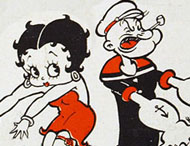 Time for another round-up of reviews for books and videos (can you believe I haven’t done this since last October? I’m hoping to resume reviewing now on a monthly basis). But before we get into it, I want to plug a couple of personal appearances coming up – these local to Southern California.
Time for another round-up of reviews for books and videos (can you believe I haven’t done this since last October? I’m hoping to resume reviewing now on a monthly basis). But before we get into it, I want to plug a couple of personal appearances coming up – these local to Southern California.
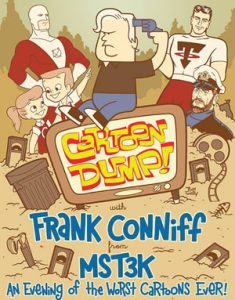 This Weekend – today and tomorrow, I’m screening a program of classic 1930 cartoons at The Old Town Music Hall in downtown El Segundo (a mile south of LAX). This is a classic old timey movie theatre with a Mighty Wurlitzer organ – and an old fashioned sing-along is part of the show! This afternoon at 2:30pm, tonight at 8:15pm and a Sunday afternoon matinee – I’ll be there introducing early-30s “pre-code” and “musical” cartoons. The GOOD stuff! If you are visiting Los Angeles – or an Angelino in town this holiday weekend – drop by for a fun show. More info HERE.
This Weekend – today and tomorrow, I’m screening a program of classic 1930 cartoons at The Old Town Music Hall in downtown El Segundo (a mile south of LAX). This is a classic old timey movie theatre with a Mighty Wurlitzer organ – and an old fashioned sing-along is part of the show! This afternoon at 2:30pm, tonight at 8:15pm and a Sunday afternoon matinee – I’ll be there introducing early-30s “pre-code” and “musical” cartoons. The GOOD stuff! If you are visiting Los Angeles – or an Angelino in town this holiday weekend – drop by for a fun show. More info HERE.
Next Week, I’ll be screening the BAD stuff at Cartoon Dump. That’s right, a one night special in Los Angeles featuring Frank Conniff and a bevy of comedians (and me) and really bad TV cartoons. Frank is now living in New York City, but is returning to highlight this show in tribute to the venue – The Steve Allen Theatre on Hollywood Blvd. – which is closing soon (to be replaced by condos). It will sell out – and it will be hilarious. Saturday June 3rd at 8pm More details on tickets here.
I’ve got other stuff coming up – most notably in July when I’ll be at both Comic Con in San Diego, CA and at Animation Block Party in Brooklyn, NY – more about those as we get closer.
Well that’s all for this month… let’s get to the reviews.
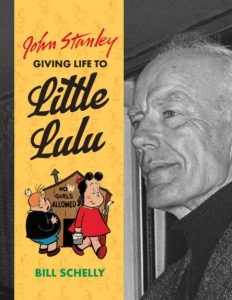 JOHN STANLEY: Giving Life To Little Lulu By Bill Schelly (Fantagraphics Books).
JOHN STANLEY: Giving Life To Little Lulu By Bill Schelly (Fantagraphics Books).
I am such a huge fan of the work of author Billy Schelly who has, in previous books, documented the rise of comics fandom, and the work of comic book greats Harvey Kurtzman, Joe Kubert and Otto Binder. Schelly now sets his sights on John Stanley, the writer and artist behind some of the funniest comic book material of the 1940s, 50s and 60s. To say this subject is long overdue is an understatement.
Stanley was one of the greats of comic books history – and probably one of the least well-known. Unlike Barks (who created Uncle Scrooge), Kurtzman (who created MAD), Kelly (Pogo), Kirby (Captain America, et. al), or Eisner (The Spirit), Stanley’s claim to greatness was more subtle. His personalty and sense of humor, and storytelling sense, was applied mainly to characters licensed from other cartoonists or Hollywood cartoon studios: Woody Woodpecker, Tom & Jerry, Nancy, Deputy Dawg, Clyde Crashcup… and especially Little Lulu.
Stanley DID create his own characters, and his own worlds, in his 30 year comic book career – and they were great too – but its his point of view that had an impact on all those who read his stories. And its his work on the Lulu series that will have the most lasting impact. Schelly traces and documents his whole career – starting at Fleischer Studios in the 1930s, and his work on Disney licensed magazines and products in the later 30s. Stanley worked in comics anonymously for decades – and later seemed to distance himself from fandom or discussing his work. Schelly did diligent, original detective work to track down surviving relatives and unearth rare photos and artwork published here.
The book is oversized and filled with great examples of Stanley’s comic book pages – from his earliest Our Gang/Raggedy Ann work through to his later Thirteen and Choo-Choo Charlie phase (and all the oddball Krazy Cat/Rootie Kazootie/Henry Aldrich stuff in between). Stanley was one of the best at his craft, a master entertainer — and I’m not sure he even knew it. He spent his later working years designing rulers for an engineering company in upstate New York.
Classic comics history and expert cartoon research. What more can I say? Yow! Buy it now.
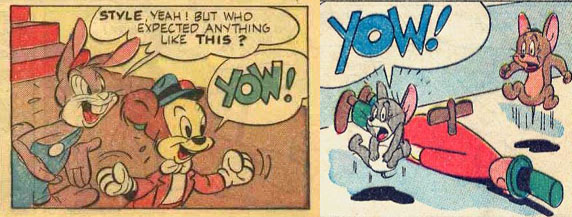
MICKEY MOUSE Vol. 10: “Planet Of Faceless Foes” Edited by David Gerstein and Gary Groth (Fantagraphics Books)
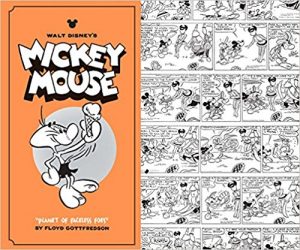 It would not be one of my review columns without a book written by, edited by, ‘translated by’ or ‘with contributions from’ David Gerstein. This month another volume – the 10th – of Fantagraphics mammoth job of collecting the Mickey Mouse comic strip work of artist Floyd Gottfredson. If you have any interest in the history of Mickey Mouse, Walt Disney, or are just a regular reader of this blog, this series is for you.
It would not be one of my review columns without a book written by, edited by, ‘translated by’ or ‘with contributions from’ David Gerstein. This month another volume – the 10th – of Fantagraphics mammoth job of collecting the Mickey Mouse comic strip work of artist Floyd Gottfredson. If you have any interest in the history of Mickey Mouse, Walt Disney, or are just a regular reader of this blog, this series is for you.
This tenth volume compiles all the daily newspaper strips from October 1948 through March 1951 – complete, restored and uncut (no matter how politically incorrect it might be on occasion). Bill Walsh (later of Mary Poppins screenplay) writes the story and gags – and continues the exploits of Mickey’s time-traveling pal Eega Beeva – which take the characters to other planets, to court, to Africa and behind the iron curtain! My favorite bit here may be the swashbuckling “The Man In The Iron Mask” continuity that teams Mickey with Gus and Jacques from Disney’s Cinderella!
These books are a delight – and I rave about each one – that’s because of Gerstein’s “bonus material” which bookend the strips at the core. Once again Thomas Andrae provides an excellent introductory overview. There’s a gallery of covers to rare foreign comic strip reprint volumes of the ‘cold war’ material; a profile of later-day Mickey cartoonist Noel Van Horn; Gerstein’s analysis of Mickey’s post war personality; and an essay on Bill Walsh’s ‘Random Anthropomorphic Syndrome’ (read the essay to find out what this is).
All this and the usual random smattering of rare, obscure Gottfredson publicity art and spot drawings, add up to another must-have volume.
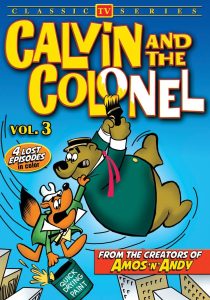 CALVIN AND THE COLONEL Vols 1-3 from Alpha Video
CALVIN AND THE COLONEL Vols 1-3 from Alpha Video
Calvin and The Colonel was part of the 1961-62 ABC prime time schedule – part of the boom of prime-time series essentially aimed at adults in the wake of The Flintstones. Comic books and toys were produced in its wake – and that’s about all you’ve ever seen of this show over the last 55 years. The main reason for its obscurity is the fact that the show stars (on the soundtrack) Freeman Gosden and Charles Correll, the creators and stars of The Amos ‘n’ Andy Show. That show – one of the most popular radio shows ever – was deemed racist in the 1960s civil rights era.
Bob Mosher and Joe Connelly, two writers from the original series – and then hot TV creators of Leave It To Beaver – had the clever idea to revive Amos ‘n’ Andy situations and its stars, WITHOUT the racial overtones, turning the characters into cartoons – funny animals, a fox and a bear. Universal produced the show and it ran for a season, 26 episodes.
Those 26 episodes only ran once on the network, telecast in black & white and were never placed in syndicated rerun (see correction in Comments below). And as the show was produced independently (at Creston Studios), not of Hanna Barbera or any of the other major cartoon studios, no one had any financial incentive to re-release it in any fashion. The stories were also a bit more adult than the average cartoon show at the time. Color prints of this series exist – but are extremely rare. Now, the good folks at Alpha Video have started to release the series to DVD. Three volumes are out ($5.99 seems to be the going price for each volume), four episodes in color appear on each disc; thus 12 episodes (half the series) are now available to collect.
The transfers seem to be from collectors 16mm prints. No restoration seems to have been done – but the shows look decent and the color is good (though that varies episode to episode). June Foray and Paul Frees provide additional voices, Gerry Ray is among the producers, Al Hubbard among the layout artists, Charles McKimson among the directors, Ben Washam, John Sparey, Bob Bemiller, Jim Davis among the animators…
This show may never be restored correctly, or officially… but for now, at this price, this’ll do. And I recommend it.
OSAMU TEZUKA Cover Art Archives
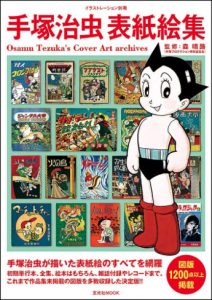 I’m a huge fan of Osamu Tezuka – Japan’s “God of Comics” and creator of modern day anime. Whatever you think of anime, Tezuka was a genius, and unquestionably a great cartoonist. I was tipped off to this volume, Osamu Tezuka’s Cover Art Archives and grabbed a copy as soon as I could find it. I don’t even recall what I paid for it. I think it’s great.
I’m a huge fan of Osamu Tezuka – Japan’s “God of Comics” and creator of modern day anime. Whatever you think of anime, Tezuka was a genius, and unquestionably a great cartoonist. I was tipped off to this volume, Osamu Tezuka’s Cover Art Archives and grabbed a copy as soon as I could find it. I don’t even recall what I paid for it. I think it’s great.
It’s a soft cover large volume, 248 pages in color and officially authorized by Tezuka Productions. It pictures every (and I mean “every”) cover for every book, magazine, reprint collection Tezuka ever drew a cover for. The first 67 pages are pre-Tetsuwan Atom (Astro Boy to you) – and Tezuka’s early work is fascinating. Very inspired by Disney – in fact, Tezuka drew a Japanese story book of Disney’s Bambi pictured here. His covers are dynamic, thrilling, beautiful. I could stare at pages in this book for hours.
The book is in Japanese, but there is minimal text. It’s a joy to behold – and if you like Tezuka’s art, and can’t collect the hundreds of volumes pictured within, this is a must-have. Good luck tracking it down. You can begin your search here.
Visual Music 1947-1986 – DVD from The Center For Visual Music
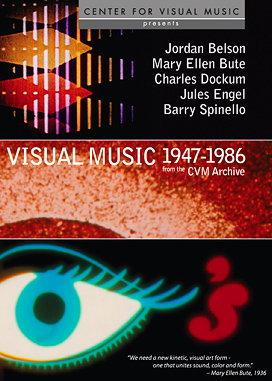 I’m not one to extoll the virtues of experimental films, but I’ve always been open to them, and have seen several that I enjoy immensely – particularly several works by Oskar Fischinger and Norman McLaren.
I’m not one to extoll the virtues of experimental films, but I’ve always been open to them, and have seen several that I enjoy immensely – particularly several works by Oskar Fischinger and Norman McLaren.
The Center for Visual Music is a nonprofit film archive in L.A. dedicated to preserving experimental animation and abstract media. They have previously released two DVD collections which, as a professor of animation history at two universities, I find invaluable – one devoted to Oskar Fischinger and the other to the works of Jordan Belson.
Their latest release is just as important – and surprisingly entertaining. Visual Music: 1947-1986 presents 13 rare and restored shorts from experimental animators Mary Ellen Bute, Jules Engel, Jordan Belson and others. I’ve read about some of these artists in Christopher Finch’s The CG Story and Tom Sito’s Moving Innovation – and its finally great to see their work and I was surprised how much I enjoyed it.
Techniques here include “pre-computer abstraction, including early oscilloscope experiments, hand drawn animation directly on film, and optical printing”. As an educator I’m particularly delighted to have these examples to show my students.
I know its not the usual cup of tea for most readers of this website… but for those of you who want to cover the bigger picture of animation history, this is worth seeking out.
Reviews (Part 2): Jim Korkis on Disney’s Gremlins; Hoot Kloot and Blue Racer on blu-ray; and Taschen’s huge new Disney Features book – Posted HERE.


 Jerry Beck is a writer, animation producer, college professor and author of more than 15 books on animation history. He is a former studio exec with Nickelodeon Movies and Disney, and has written for The Hollywood Reporter and Variety. He has curated cartoons for DVD and Blu-ray compilations and has lent his expertise to dozens of bonus documentaries and audio commentaries on such. Beck is currently on the faculty of CalArts in Valencia, UCLA in Westwood and Woodbury University in Burbank – teaching animation history. More about Jerry Beck [
Jerry Beck is a writer, animation producer, college professor and author of more than 15 books on animation history. He is a former studio exec with Nickelodeon Movies and Disney, and has written for The Hollywood Reporter and Variety. He has curated cartoons for DVD and Blu-ray compilations and has lent his expertise to dozens of bonus documentaries and audio commentaries on such. Beck is currently on the faculty of CalArts in Valencia, UCLA in Westwood and Woodbury University in Burbank – teaching animation history. More about Jerry Beck [



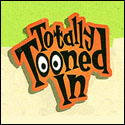



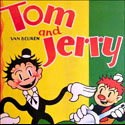
I’d like to add another recommendation that I’m sure will be of interest to readers of Cartoon Research – HERO-A-GO-GO! CAMPY COMIC BOOKS, CRIMEFIGHTERS & CULTURE OF THE SWINGING SIXTIES by Michael Eury. A lavishly produced book with almost entirely full-color illustrations, it contains a lot of fun essays about ’60s cartoons and comic books, including a seven page interview with Ralph Bakshi regarding The Mighty Heroes, his time at Paramount, and Spider-Man.
I have been taking my time poring through it, because I don’t want to end the pleasure of reading it. I’m genuinely surprised Jerry didn’t include it, as its right in his wheelhouse.
Hey – I haven’t seen that book yet. Sounds great! Thanks for the suggestion, I’m ordering it now!
Speaking of Tezuka. I’d like to suggest this set that came out in Japan a long time back that might be of interest to readers of Cartoon Research as well – the Osamu Tezuka Storyboard Encyclopedia. It is essentially an encyclopedia set with each volume containing storyboards and model sheets for a number of his shows and specials.
I, personally, have one set dedicated to Princess Knight, Kimba and Wonder Three and another set dedicated to his all-star special, Marine Express. Despite the production notes being in Japanese, the artwork is clean and a wonder to look at. Especially since a number of these shows never made it out of Japan, even being able to see the storyboards is a treat.
Glad to see “CALVIN AND THE COLONEL” being put out. I was hoping that Steve Stanchfield would have taken on that project, neatly restoring the episodes to as good as possible quality, and *ALL* in color. I’m anxious to see the episodes that have not been shown since the show’s original airing. 26 episodes in all? I’ve only seen about 12 or so, and the others seem to be missing…this is not a review of the disks mentioned here. I have not heard those, so I have yet to enjoy the quality of those, but I will definitely look ’em up and, for what it is worth, I’m looking forward to “SHERIFF HOOT KLOOT” and “BLUE RACER”. I’ve never checked out the latter, so I don’t know what to expect, but I’m sure that “HOOT KLOOT” will contain recyclings of Warner cartoon plots and interesting voice work overall. Hey, I’m not expecting the kind of quality that used to be inherent in classic LOONEY TUNES and MERRIE MELODIES, but at least it is something. Here’s hoping there is good news down the road for some of our favorites. I never stop hoping, although the pilot light is fast waning on that one.
I have GOT to get those three Calvin and the Colonel DVDs. I have a few on the Giant 600 Cartoon Collection Mill Creek put out years ago, but no color prints.
Actually “Calvin and the Colonel” was briefly in syndication in the middle 1960’s.
KHJ (9) (now KCAL) had the show for a brief while, and ran it in a 2:30 or 3:00 time slot. This was in the summer of 1965.
In its original network run, “Calvin and the Colonel” was walloped by the third season of “The Many Loves Of Dobie Gillis” on CBS.
Joe Connelly and Bob Mosher came on board with “Amos ‘n Andy” when that show converted from a five-a-week comic serial to a half-hour situation comedy format. That was with the 1943-44 season. Many episodes of this format of the radio series circulate in collectors’ hands.
With a little research it can be discerned if any of the episodes of “Calvin and the Colonel” are retreads of “Amos ‘n’ Andy” scripts, and, if so, which ones.
GTV-9 in Melbourne aired them in colour in 1982
Jerry, if you don’t object to a correction, it is not true that CALVIN AND THE COLONEL was never syndicated. I have a clipping in my files, dated May 1964, in which MCA-TV announces CALVIN’s release to the syndication market. In addition, I have a 1968 catalog from MCA-TV of their syndicated offerings, and CALVIN AND THE COLONEL is listed there, noted with “26 animated half-hours in color.”
No – I never object to corrections on my posts – or to any posts on this site. I welcome them and thank you (and James above) for more clarification on the after-network life of Calvin And The Colonel. This explains why there are color prints around (though scarce).
Well at least MCA cared to keep the show around for any station that may’ve cared to air it. Certainly can’t be said of the current NBC Universal group today.
I may have missed it in the article, but is it certain that all 3 volumes of Calvin and The Colonel have all the episodes in color?
Always good to see a new Jerry Beck post on this site! 🙂
Jon/Jerry, you guys should tell Alpha Video about the syndication of Calvin and the Colonel, too. The back cover descriptions on all their DVDs so far state that the series “never went into syndication”.
Been hocking my friends at Universal for years about licensing this series to another company and/or one of the nostalgia channels. Less than zero interest. This at least is better than zero.
I was wondering about that. So — the Calvin and the Colonel DVDs from Alpha Video are 100% unofficial and unlicensed? How does that work, exactly? Is the show somehow in the public domain…?
AFAIK, they’re not PD. My guess is that Universal isn’t going to waste time and money going after some tiny company releasing material they themselves have zero interest in licensing out themselves.